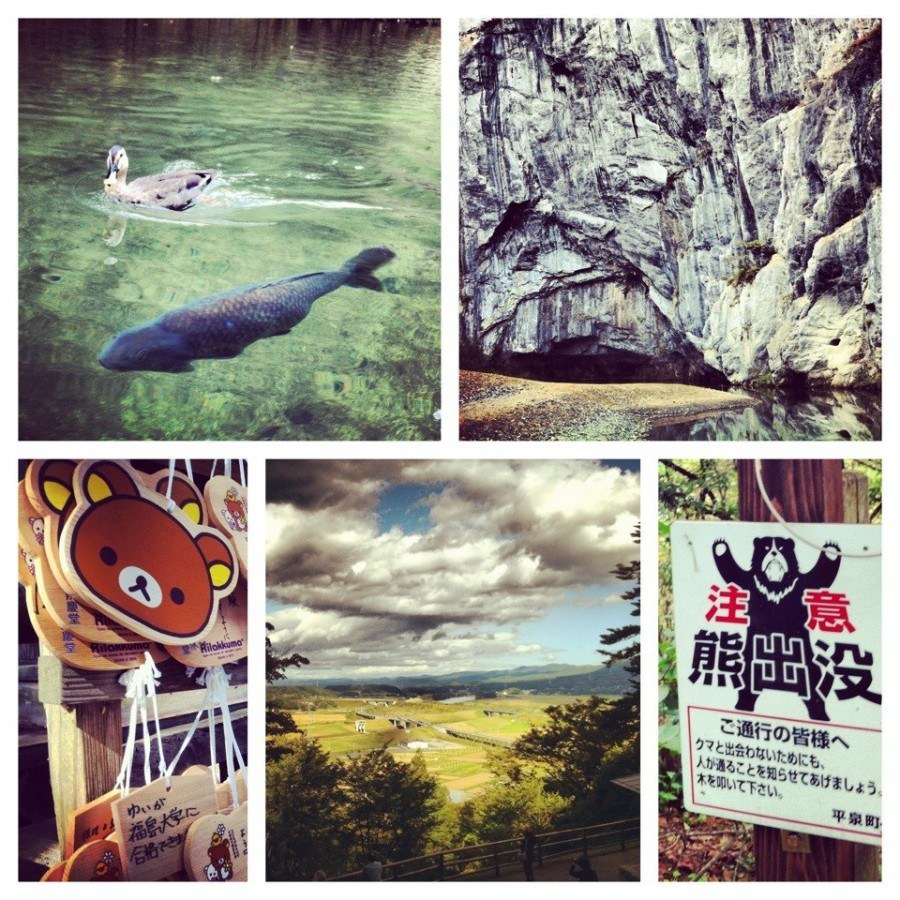Like this post? Help us by sharing it!
Just fifteen minutes ago, before sitting down to write this, I was plunging into an outdoor hot-spring on the roof of my ryokan (Japanese Inn) watching the sun set over Sado Island, a lesser known destination off Japan’s north-west coast. With steam pouring into the cool air around me, I watched as the clouds and verdant hillside of Mount Kinpoku turned orange and then pink and purple as the sun dipped ever lower on the horizon, before finally disappearing into the distant Japan Sea. I was thoroughly lost in the moment, and I would have happily stayed that way had I not remembered that I was sharing this ‘magical moment’ with the four naked Japanese men who were also in the hot-spring. Strangely, and not necessarily for the better, I have grown all too accustomed to jumping into baths with naked strangers. Indeed, every night on my two week trip around Tohoku (northern Japan excluding Hokkaido) my companion and I have done as the locals do and finished off a long day of sightseeing with a dip in the onsen (hot-springs).
Yet this experience, as undeniably special as it was, has been only one among many. Which got me to thinking about what I like best about Tohoku.

Food! Food, food, food…. and food. At times it felt like we simply sightseeing in order to fill time until the next meal. Sure enough, delicious food can be found all over Japan but there is a plethora of local specialities in the north that make it different and exotic, even to a Japanese ‘foodie’ like myself. Staying in temples, hotels, and ryokans, every night has been a feast as artfully presented and as delicious as the one before. Fresh sashimi, whole crabs staring me in the face, tender slabs of marbled wagyu beef, oysters, nabe stews, noodles, tofu, black skinned pork, fried chicken, sushi… just to name a few.

A visit to one of the tsunami stricken areas is a harrowing experience but, for me, it was also one which inspired hope, reaffirmed my belief in the goodness of communities and their ability to come together in the face of disaster, and reminded me of just how many selfless organisations and individuals are working to rebuild the cities, houses, and neighbourhoods that were completely and utterly destroyed 19 months ago. The very short time that I spent volunteering in Ishinomaki is an experience that money simply can’t buy, and one that I would recommend to anyone with the desire to make a difference.

Just a few short hours north of Tokyo is one of my favourite places to visit in all of Japan. Aside from the architectural masterpieces for which the area has become famous for, Nikko has great hiking, postcard perfect waterfalls, colourful foliage in autumn, wild monkeys and serrows, hot-springs, and cool summers. By all accounts, this is a “must-see” destination. Of course, as with most “must-see” spots, there is rarely a quiet day when you can get the best sights to yourself, which is all the more reason to make sure you spend the night at a traditional inn near the temples and go for a wander at night once all the crowds gone home to Tokyo.

I ride on the comfortable Tokkaido shinkansen (the bullet train running between Tokyo and Fukuoka) weekly and spend much of that time gazing out the window watching as neat rows of exquisitely manicured green tea plantations and the many rice paddies squeezed between houses and cities whiz by. Some days even Mount Fuji makes an appearance. Yet every time I make this journey I am simply amazed at how developed this densely populated corridor of Japan is.
In northern Honshu (Japan’s main island) life moves at a slower pace, nature still reigns supreme, and small towns outnumber big cities. For anyone who has only been west of Tokyo, a trip up north will reveal a different side of Japan; and if you’ve never been to Japan at all, this might just be the Japan you’ve always imagined.

The last on my list is most certainly not least; Haguro San is the smallest of three sacred peaks in Yamagata prefecture but it is far more than just another hill.
From what felt like a very ordinary road running through the middle of a small town, I stepped off the bus and walked no more than 20 metres through an old Buddhist gate and found myself in another world altogether. A bit like Narnia but without the talking animals. 2446 stone steps cut through giant cedars, lead me over an arched red wooden bridge, past a 1000 year old cedar tree, around a 600 year old ornate wooden five-storied pagoda, into a teahouse for a well deserved rest, and finally on to my accommodation, a Buddhist temple turned Japanese inn at the peak’s summit.
The quiet air and reverent atmosphere at the top of this pilgrimage destination left me forgetting completely about the cares and worries of my daily life in Tokyo. Instead of opening up my computer or flipping on the TV once the sun went down, I changed into my yukata (a light cotton kimono), had a boil in the temple’s bath and then sat down to a delicious almost-vegetarian feast and a large ice cold beer. This was surely the closest I was going to come to having a religious experience.


